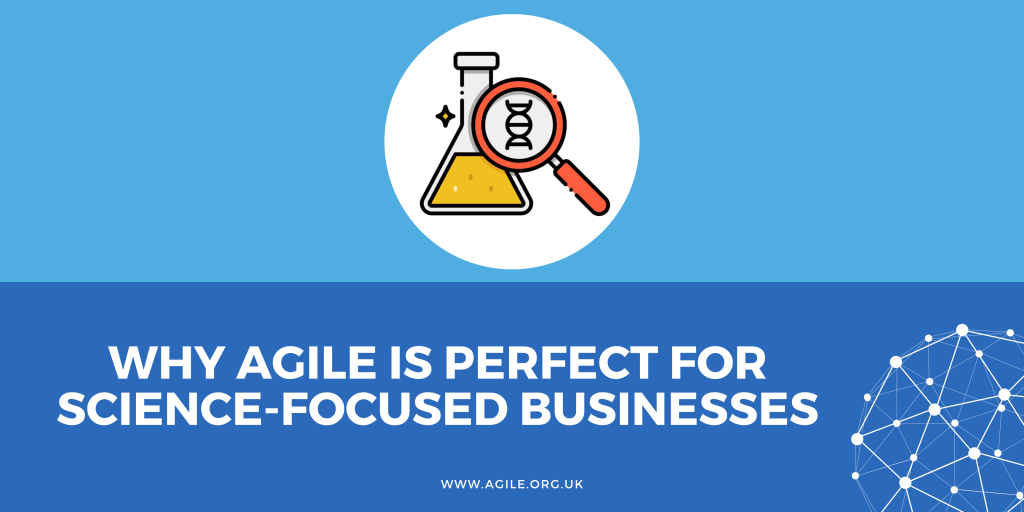The agile framework is ideal for a lot of different industries and business types, but arguably one of the best-suited industries when it comes to agile’s implementation is science.
If your business is focused on science – whether it be working alongside the best chemical distributors UK industries have to offer, creating new innovations in tech, or any other scientific endeavour – then you should seriously consider agile as a framework.
Why is that, though? Read on and we’ll discuss why agile is perfect for scientific businesses, as well as how you can implement it in your business!

What exactly is agile?
First, it’s important to define what we mean when we talk about agile methodologies.
In essence, agile is a framework that allows businesses to get things done quickly without worrying about constant micromanagement or reporting back every five minutes.
While the term originated in software development, it’s since grown to encompass many different business types, so even if your business isn’t focused on software, agile could be the right approach for you.
The twelve principles of agile working are a great way to begin thinking about agile frameworks, and they can often be applied to businesses in a one-size-fits-all sense as well.
Why is agile good for science-focused businesses?
Now that we’ve established our definition of agile working, we can think about why this methodology is good for science-focused businesses.
In short, most science-focused businesses are looking to create value and innovation without being stymied by checks and balances at every turn.
That’s what agile allows businesses to do; you and your team can focus on the project or task at hand without meeting constant barriers and blockades.
Let’s take a look at some of the reasons agile working is great for scientific business ventures.

Agile began in software development
The agile framework originated in software development, and although some of its core tenets feel specific to software, they’re actually more general than you might think.
More broadly, however, the fact that agile began in software means that the framework has already been used in a provable sense when it comes to a key scientific industry.
That means you know that if you’re incorporating agile into your business, you can be sure it’ll carry over with minimal adjustment or effort required on the part of either you or your company.
Agile frameworks allow businesses to move faster
Traditional business operation often has layers of management which are incorporated into every task at the bottom level.
While this can help in terms of keeping projects on track, it often leads to excessive bureaucracy; when each decision has to be checked by several individuals, the process of a task can grind to a halt.
Agile methodologies leave businesses free to pursue tasks and goals in whatever manner they choose (within reason, of course), and while management isn’t absent, it’s less intrusive than it can seem in other business frameworks.
If you’ve ever experienced a task coming to a stop because of too much managerial interference, agile is for you.
Agile focuses on technological innovation
In 2020, life changed completely for a huge number of people, and while many of those changes weren’t exactly positive, remote and hybrid working looks like it’s here to stay.
Agile loves remote and hybrid working, because it focuses on technological innovation and software solutions that can help teams achieve goals more easily and quickly.
Scientific industries and businesses also revolve around technological innovation, which means that science and agile are a match made in heaven.
When your business relies heavily on apps, automation, and technology, then you know that agile is something you should be considering.
Agile is all about results
Naturally, scientific businesses must follow a process in the same way as other businesses do. “Science” is a broad and catch-all term, but it effectively means research, innovation, and progress.
With that in mind, the results of the process are the most important part; scientific businesses are often working on products or services that will be genuinely transformative to a large number of lives.
Agile methodologies allow businesses to focus more on the “deliverables”, which potentially means real change for individuals on the ground level.
When the most important thing for your business is making sure you achieve something tangible, then make sure you’re considering agility in your approach.

Agile adapts well to change
If you work in the sciences, then you’ll know change is constant and irrepressible. You shouldn’t fear change when you work in science; instead, you should embrace it.
Happily, that’s something agile can help your business to do as well. Since agile frameworks revolve mainly around optimising pipelines and preventing bloat, change can be adapted to swiftly and easily.
Of course, that will depend on your implementation of agile frameworks as well, so make sure you’re working closely with your organisation to put the right kind of agility in place.
Done well, however, agile is the perfect framework for a business that constantly needs to adapt to a changing landscape.
Agile can prevent businesses from being overwhelmed
Scientific industry can often suffer from a feeling of being overwhelmed, with employees struggling to comprehend the size and sheer scale of many tasks.
Agile can assist those employees to focus on smaller, more “bite-sized” goals, which fit neatly into the larger project and are much more manageable.
When the scale of the task feels like it’s becoming insurmountable and you feel like your employees need to refocus, agile can provide the perfect opportunity for them to do so.
Just be aware that, like any other business style, agile will need your support in order to succeed!
Conclusion
As you can hopefully see from our outline above, agile is the ideal way to run a science-focused business on a day-to-day basis.
It helps to keep goals manageable, visible, and achievable, and it should hopefully result in a higher level of employee happiness across the board as well, so it’s a win-win!













